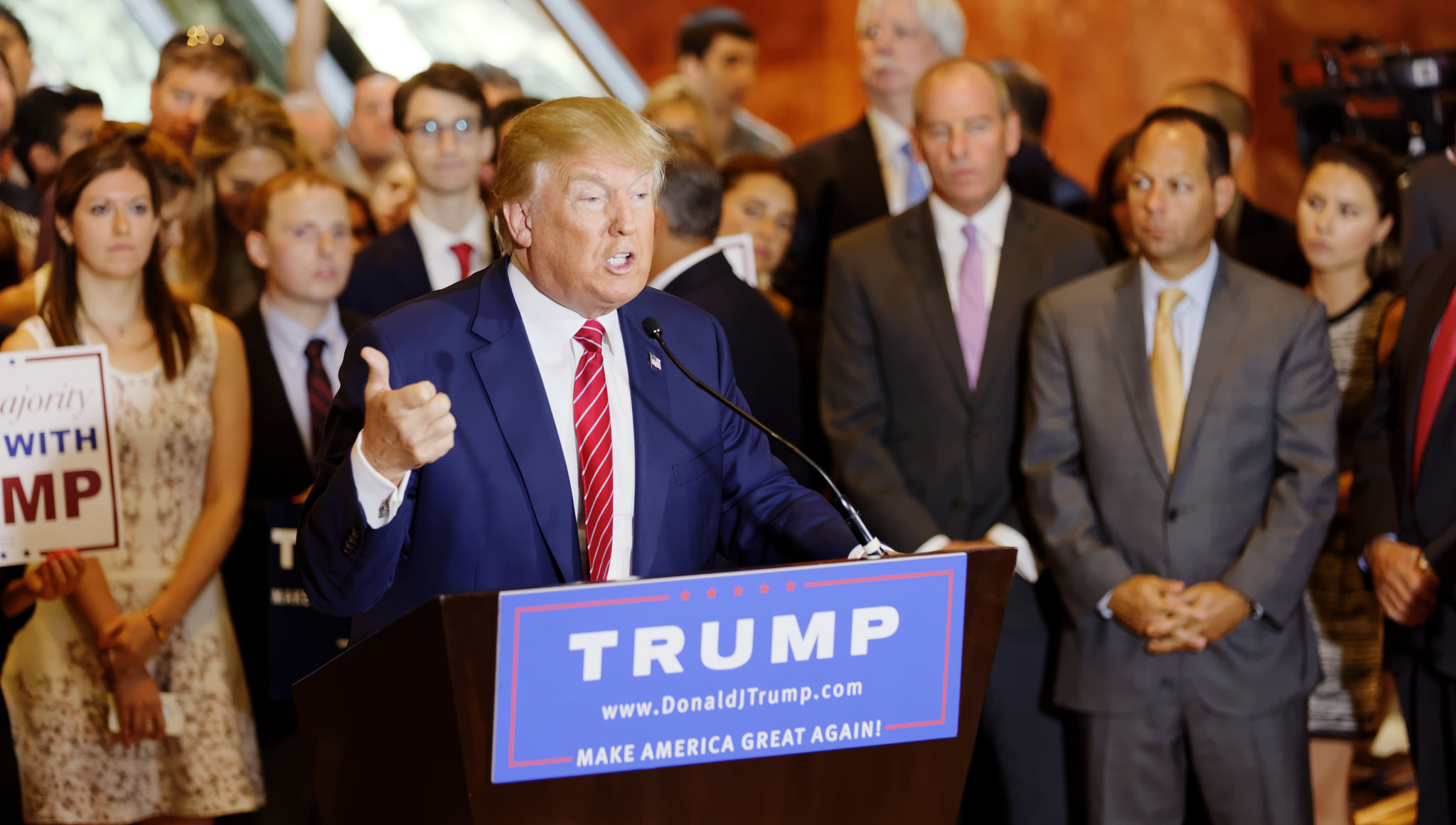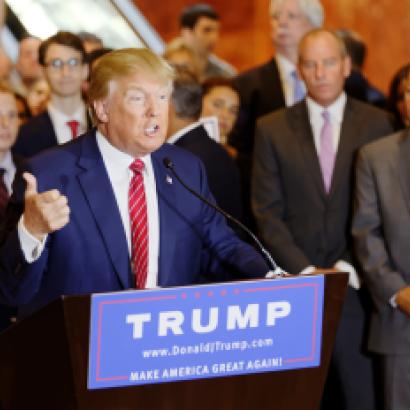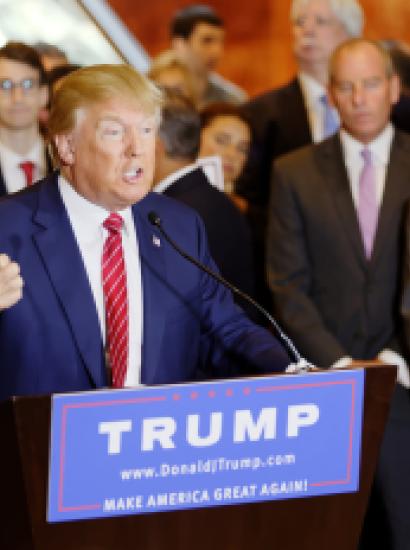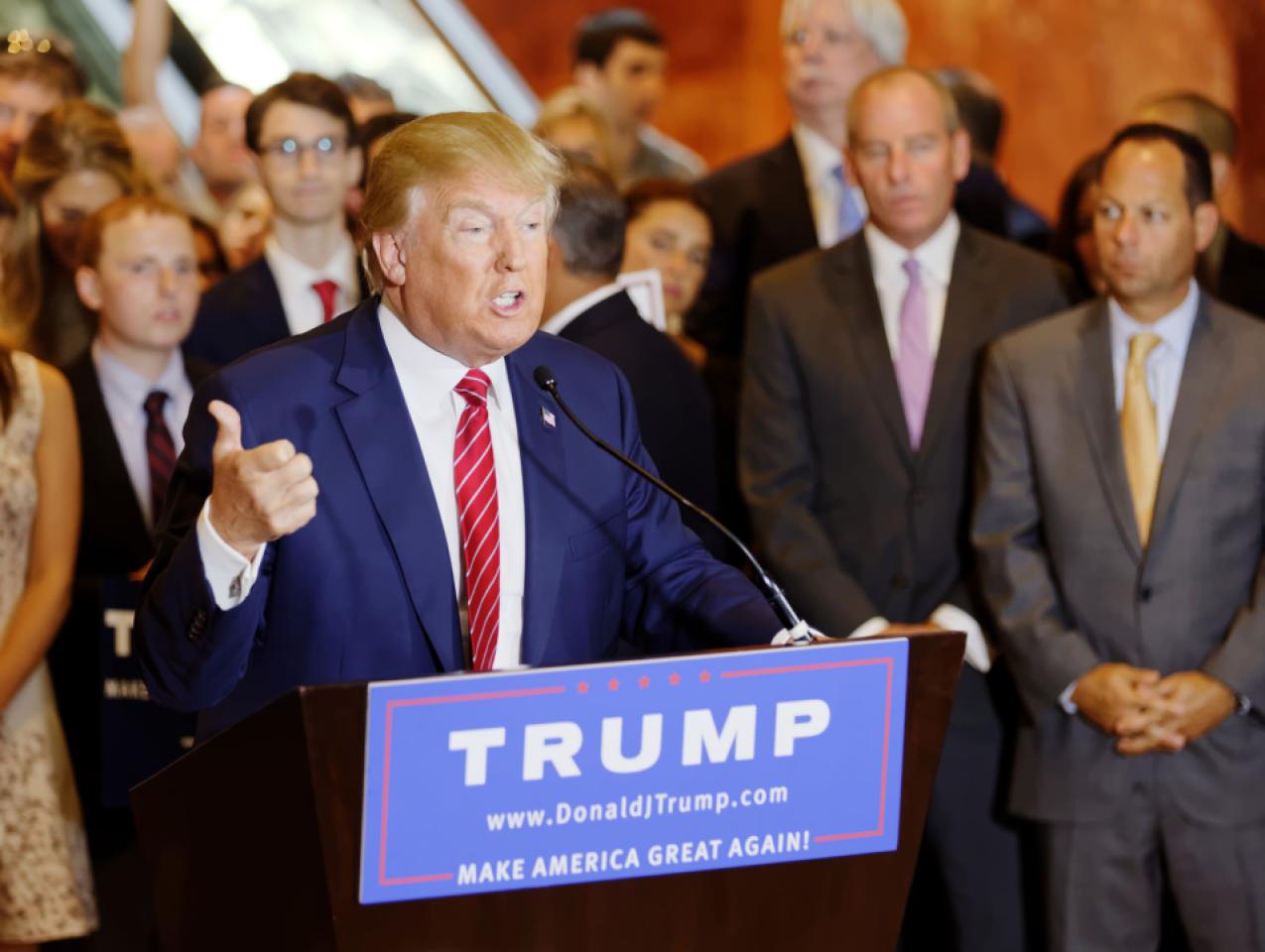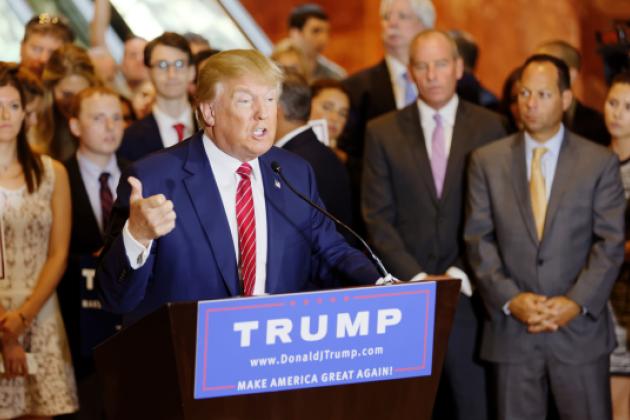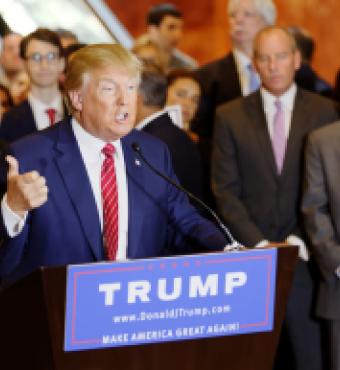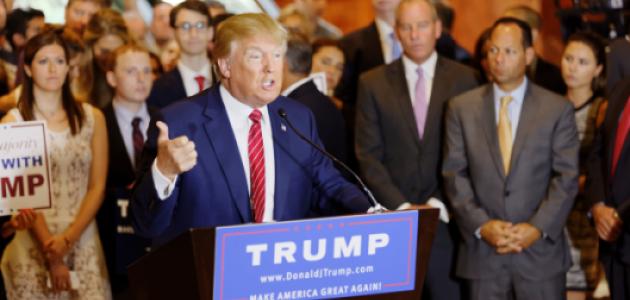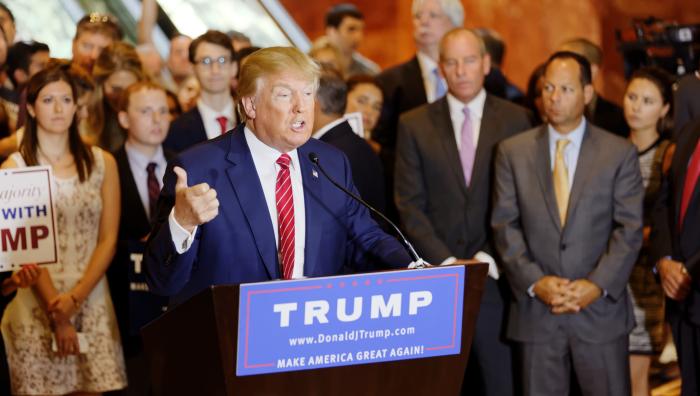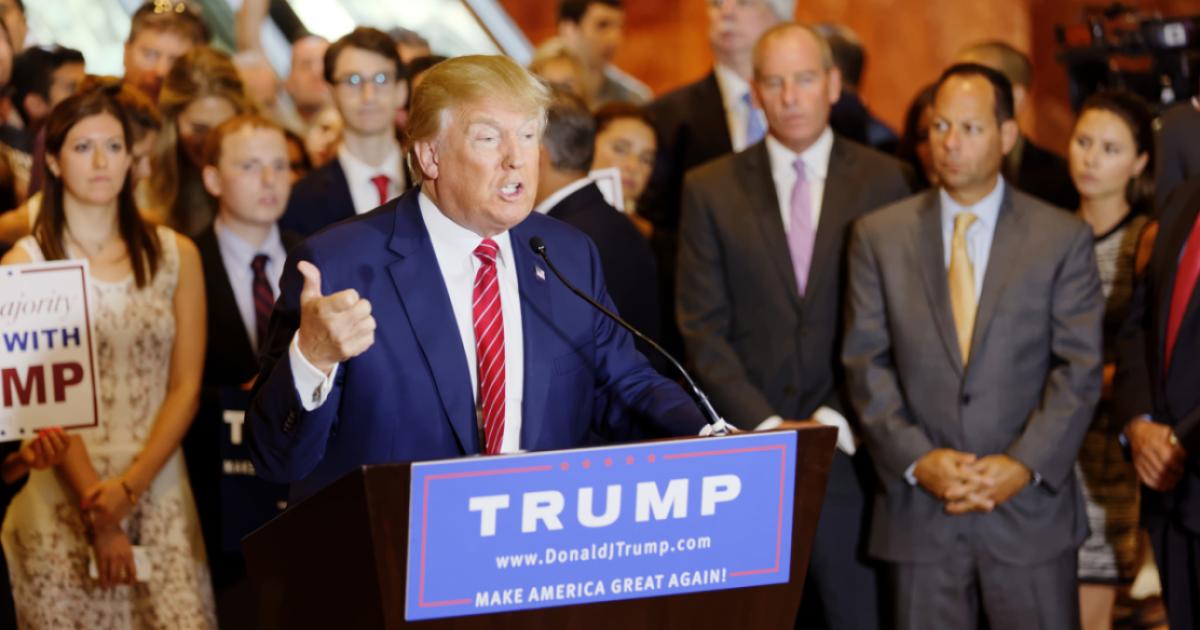- Politics, Institutions, and Public Opinion
Twitter feuds, hero bashing, insulting not one but two ethnic groups, ad hominem personal attacks on opponents, nose-to-nose confrontations, just one scandal after another—these aren’t from episodes of Keeping Up with the Kardashians—they’re from the “Trump Saga.”
At the outset of the campaign, Trump insulted anyone and everyone: from calling undocumented immigrants “killers” and “rapists” to insulting venerated war hero John McCain. He then moved on to TV host Megyn Kelly, radio host Eric Erickson, Univision reporter Jorge Ramos, the pope, Carly Fiorina, and the Fox News Channel.
Democrats and Republicans alike didn’t take Trump too seriously when he entered the race in June, but as his list of gaffes increases, so does his list of supporters. In a campaign that is changing daily, Trump’s candidacy has shown a pattern of increased support. Current polling continues to show Trump as the leader among the Republicans. He polled at 6 percent in early July; by late July he had taken the lead from Jeb Bush. The most recent CNN poll shows him continuing to lead the pack, with 24 percent of Republicans and Republican-leaning independents favoring him.
Trump has somehow weathered one faux pas after another and, despite being viewed more unfavorably than any other candidate, he has fought off one Republican opponent after another. His newest significant antagonist, after “winning” the second debate, is Fiorina. Ben Carson and Marco Rubio are not far behind, while Bush, Cruz, and Christie are clawing just to keep up. Thus far, Fiorina is the only candidate who has been able to slow the Trump steamroller, as for the first time since late July, his lead fell to below 10 percent over his closest competitor.
So why is Trump still so popular in the polls, and why do we keep watching him and talking about him?
At first blush, Trump’s popularity could be attributed to the same reasons we watch any reality TV show—the backstabbing, insults, and ongoing feuds: our fascination and obsession with confrontations, catastrophes, disasters, and with the unusual. In truth, we’ve never seen a candidate like this before. What candidate in recent memory has said of another candidate, “Look at that face. Would anyone vote for that”?
But there is more to it than that. Consider the three leading Republican presidential candidates at the moment: Trump, Fiorina, and Carson. What do a controversial real estate mogul, a retired neurosurgeon, and (some say) a failed business executive have in common? None has ever held elective office; they are all political outsiders.
Which leads us to another current obsession with Americans: disgust with our Washington politicians. Trump, Carson, Fiorina, and even Rubio (a first-term senator) offer an alternative. Trump, Fiorina, and Carson do not have strong ties to the Republican establishment. Rubio is a bit of a GOP outsider too. He came to Washington in 2010 as part of the Tea Party revolution.
Trump is clearly espousing a message of change from business as usual. Tapping into voter discontent, his message resonates with a large bloc of the electorate. He is reaching those voters who feel left out, whose voices are not heard—people who are angry with the system as a whole. Just as candidate Obama offered a program of “hope and change” in 2008, candidate Trump (channeling candidate Reagan from 1980) is offering to “make America great again.” Other candidates see the popularity of this message and have since echoed it; in a recent interview, Ted Cruz said, “We recognize that people are hungry for change—they recognize what we’re doing isn’t working.”
Trump sees that people are angry, and he, in turn, says that when he becomes president, things will be different. He argues that he’ll run the U.S. government like a business, creating new jobs and generating profit for all. Of course, he rarely brings up two key facts. First, his business success has been tumultuous—he was forced to file for bankruptcy four times. Second, he is not a self-made man—he received a great deal of his wealth and his start in business through inheritance.
Regardless of his message, something seems to be resonating convincingly with voters. A recent YouGov survey of Republicans and those leaning Republican found Trump’s supporters are conservative and a little older, less well educated, and have lower incomes than the typical Republican. The question is: Are those survey respondents who are “leaning Republican” going to vote in the primaries and in the general election? If so, will they be able to carry the day and provide the swing votes necessary to win a national election?
Trump may be aided by the voting trends of those forty-five and older, which is a group to whom he appeals. Since 1996, the voting volume in presidential elections by those forty-five and older has been trending upward—likely a reflection of the aging of the Baby Boomers. They represented 61 percent of the vote in 2012, up from 53 percent in 1996. The YouGov survey showed that more than 80 percent of Trump’s supporters were forty-five and older.
The first caucus and primary are four months away. Can Trump survive what no doubt will be an onslaught from the Republican establishment? Not likely. The political landscape is littered with candidates espousing extreme left or right views during the primary season. One has to look back only four years to Michele Bachman.
According to the Pew Research Center, less than half of Americans consider themselves Democrats or Republicans. In the primary season, candidates appeal to their more liberal or more conservative constituents, only, in most cases, to head back toward the center for the general election. Although the data show his followers are conservative, Trump is more of a new-age populist and may successfully appeal to that majority that refuses to identify with either of the major parties: people who are looking beyond the “political machine” for answers to our government’s most pressing issues.
The future of our nation is a serious issue—not a reality TV series. Ongoing threats from ISIS and Iran loom on the horizon, and national issues such as healthcare, income inequality, immigration, and the race and culture debates need to be handled with diplomacy and forethought, not with hostility and tactlessness.
Trump was famously not up to speed on the Kurds and the Quds, and he stumbled in the second debate on questions regarding state finances and foreign policy. He notably mentioned that Wisconsin has a $2.2 billion budget deficit (it doesn’t) and later admitted his ignorance of foreign policy and excused it with the statement, “I will know more about the problems of this world by the time I’m sitting.” What kind of an experienced policy team can Trump put together when the next words out of his mouth could be “You’re fired”? Indeed, in August, his top campaign adviser, Roger Stone, quit amid all the controversy surrounding his campaign.
After waffling at the first debate, Trump signed a pledge to support whomever the Republican candidate is, seemingly negating the prospect of a run as an independent. But will his supporters—those who want to make America great again—be satisfied? Trump’s announcement that he’d signed the Republican loyalty pledge was welcomed with tepid enthusiasm by those in the audience; the applause seemed half-hearted. A well-funded independent run is not so far-fetched, and stranger things have happened on reality TV. We’ll see if the “Trump Saga” appears in 2016—on an independent channel or on one of the majors.







